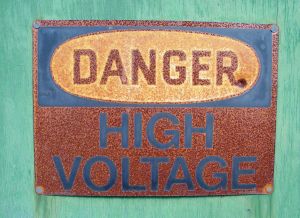 Over one thousand electrical accidents at work involving electric shock are reported to the Health & Safety Executive (HSE) each year.
Over one thousand electrical accidents at work involving electric shock are reported to the Health & Safety Executive (HSE) each year.
Faulty electrical installations and equipment are also a common cause of fires in commercial and industrial buildings, second only to arson.
It is essential that risks associated with electrical installations (often referred to as ‘fixed wiring’) and equipment are correctly assessed and controlled.
Legal requirements
Electrical safety in the workplace is governed by the Electricity at Work (EAW) Regulations 1989. They require that the electrical system shall at all times be constructed and maintained “so far as reasonably practical, to prevent danger.”
The word “system” includes fixed electrical installations, i.e. the wiring and switchgear installed in the building and permanently fixed equipment, such as; motors, compressors, heaters, lighting, etc.
IET Wiring Regulations BS 7671:2008
The EAW Regulations do not specify how frequently electrical equipment should be maintained or what records should be kept. These are covered in the Institution of Engineering and Technology (IET) Wiring Regulations BS7671 and the supporting IET publication Guidance Note 3: Inspection and Testing.
BS 7671 is a code of practice which is widely recognised and accepted in the UK. Installations that comply with BS7671 are likely to satisfy the relevant parts of statutory regulations such as the EAW Regulations. However, in circumstances such as in licensed premises where specific requirements may differ from those of BS 7671, these will take precedence.
Periodic inspection and testing
The purpose of periodic inspection and testing is to provide an “engineering view” on whether the installation is in a satisfactory condition and can be used safely. This involves a detailed visual examination together with appropriate testing.
Based on IET recommendations, inspection intervals will normally range between 1 & 5 years, depending on the type of installation and occupancy. Typically
Industrial – 3 years
Offices – 5 years
Retail – 5 years
Educational establishments – 5 years
Restaurants and hotels – 5 years
Petrol filling stations – 1 year
Intervals less than those outlined may be recommended when the installation has suffered from neglect, or where it has been adversely affected by usage or environmental conditions.
A full list of all occupancies and the corresponding recommended inspection frequencies is published by the IET in Guidance Note 3.
Following the periodic inspection and test, an Electrical Installation Condition Report (formerly known as a periodical inspection report) is required, in which the installation is assessed in terms of its suitability for continued use as either “satisfactory” or “unsatisfactory”.
In the case of an “unsatisfactory” installation, the report will incorporate remedial measures categorised as:
C1 – Danger present. Risk of injury. Immediate remedial action required. The IET recommends that such items should be made safe on discovery, either by effecting immediate repairs or by taking the offending item or circuit out of service.
C2 – Potentially dangerous. Urgent remedial attention required.
C3 – Improvement recommended
Other electrical and testing protocols
Inspection and testing is also recommended by the IET:
• To assess compliance with BS 7671
• On a change of occupancy or use of the premises
• After alterations or additions to the original installation
• Any significant change in the electrical loading of the installation
• Where there is reason to believe that damage has been caused to the installation.
Routine checks
As well as formal periodic inspection and testing, the IET advocates that documented routine checks of the installation are carried out between inspections (in the majority of cases at annual intervals). The IET advises that these routine checks need not be carried out by an electrically skilled person, but should be done by someone who is able to safely use the installation and recognise defects.
Thermographic testing
Thermographic testing (also referred to as thermal imaging) is widely used in commercial and industrial premises as part of preventative electrical maintenance. It is not intended to replace conventional periodic inspection and testing, but is promoted as an additional activity with the objective of identifying electrical faults at an early stage.
Choosing electrical contractors
Select from contractors that are members of the National Inspection Council for Electrical Installation Contracting (NICEIC), the Electrical Contractors Association (ECA), the ECA of Scotland (SELECT) or other appropriate UKAS accredited organisations. Electrical inspection and testing is also available from some leading insurers as part of their engineering inspection services.
Requirements of insurers
Some Insurers apply electrical inspection conditions within their commercial property and business interruption covers and therefore it is important that these are checked and complied with in full.
Further guidance
The HSE has a specific webpage dedicated to electrical safety which can be found at www.hse.gov.uk/electricity/index.htm
Information on electrical inspection and testing is also available from the IET at www.theiet.org
If you would like any advice on your own business risk or the insurance you have in place, please get in touch with us at Greenfield Insurance on 01489 579808.












Leave a Reply